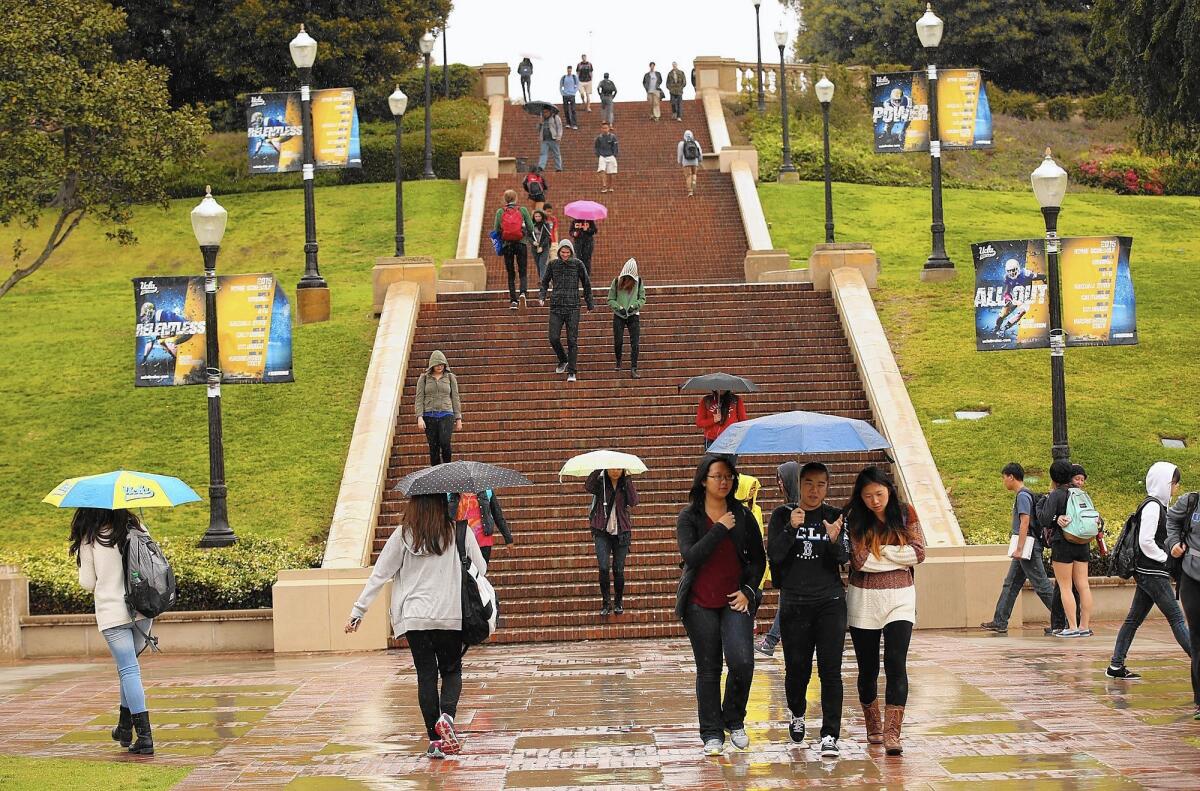Law school continues fight over minimum bar exam passage rate

- Share via
When the State Bar of California began requiring some law schools to maintain a minimum bar passage rate to keep their good standing, one school pushed back.
The Southern California Institute of Law, which has campuses in Santa Barbara and Ventura, took the unusual step of suing the state bar to overturn the regulation.
A bar association committee in 2012 approved regulations requiring accredited law schools to maintain a 40% minimum passage rate over five years or risk losing their accreditation.
See the most-read stories this hour >>
Administrators at the nearly 20 schools that were accredited by the California bar complied with little complaint; many had already made bar preparation a mandatory part of their curriculum or had agreements with test prep companies that would help their students cram for the state’s legal licensing examination.
Nationally accredited law schools on campuses such as USC and UCLA are required to have a 75% bar passage rate in three out of five years.
Southern California Institute of Law administrators argued that the new regulations were unconstitutional and said that they would harm minority, lower-income students who generally attend accredited law schools.
“The proposed guidelines will destroy those opportunities for many of those who otherwise lack the opportunity to at least pursue their dreams,” according to the lawsuit.
Stanislaus Pulle, the school’s dean, said he thought the bar passage rate was generally a fair way to judge law schools. But he added that he believes the state bar’s requirement was too rigid and would force schools to accept students who had a higher chance of passing the bar and ignore other types of students. The Santa Barbara campus typically enrolls about 20 students annually, according to state bar records.
The Society of American Law Teachers, an advocacy group based in Las Vegas, has also cautioned against relying too heavily on bar passage rates as an accreditation measurement.
“It is our responsibility to help those who are new arrivals, who are new immigrants, who come from lower socioeconomic backgrounds,” Pulle said. “Is the only way these students are going to pass is to give them a McDonald’s education or is it to challenge them to think for themselves?”
The suit was thrown out by a judge two years ago, but school officials appealed the decision. The U.S. 9th Circuit Court of Appeals heard arguments in the case in August and upheld the dismissal later in the month. Pulle said last week that the school would ask for another hearing.
Accredited law schools are four-year, part-time programs that cater to older adults who are often switching professions while also holding down a full-time job. Tuition is cheaper than nationally accredited law schools, sometimes as little as $5,000 annually, although a few of the schools charge nearly $18,000.
Instead of training attorneys who could work at large, civil firms, most accredited law school administrators say their aim is to produce attorneys who can represent working-class clients or work for the government.
“We’re in the business of producing qualified, competent mechanics who can day in and day out assess the basic needs of clients and find a cost-effective way to solve their problems, not work for the rare, sophisticated corporate client,” said Mitchel Winick, the president and dean of Monterey College of Law, which also has a campus in San Luis Obispo.
That school hired a full-time staff member to help raise its bar passage rate, which administrators say is about 58% over the last five years.
Accredited law schools’ five-year bar passage rates are not publicly available, but bar officials said they plan to post those statistics soon.
About 45% of students at accredited law schools make it to their final year of study, according to a Times analysis of state bar data. Nearly 30% pass the bar the first time they take it, according to state data. Prospective attorneys can take the bar multiple times.
State bar officials are also considering extending the 40% bar passage rate to unaccredited law schools, which are cheaper than accredited schools and also include the state’s online schools, which are currently not certified by the state bar.
About nine out of 10 students at unaccredited law schools don’t make it to their fourth year, according a recent Times investigation. And about 20% of those who take the bar pass, according to state statistics.
Tuition at the Southern California Institute of Law is among the lowest in the state at about $8,000 a year. When broken down into monthly payments, the cost is about the same as a car payment, said Kevin Mauseth, the school’s admissions director, who also graduated from the school.
“That’s doable for a lot people and it won’t depreciate as soon as you walk off the lot,” he said. “They will still have to push [financially], but it is what it is.”
Students say that they are aware of the school’s track record.
Sarah Ali Khan said she was shocked when she checked the campus’ July 2012 bar passage rates when 17 alumni from the Santa Barbara campus took the bar and none passed.
The statistics “were abysmal, but they were also motivating as well. It gave me a sense of urgency, that I was betting on myself,” said Khan, who reasoned that the school’s low tuition mitigated concerns over the school’s bar passage rate.
But others say that they preferred a school with a higher success rate.
Southern California Institute of Law “didn’t seem like the right place for me,” said Erika Martin Del Campo, who attends the Santa Barbara College of Law, a nearby school which charges nearly $61,000 over four years but has produced 32 attorneys over the last two years compared with three from the Southern California Institute’s Santa Barbara campus, according to state records.
The Santa Barbara College of Law also began phasing in a bar review course as part of its curriculum, something Pulle scoffs at, calling it a “one size fits all” approach to legal scholarship.
Southern California Institute of Law administrators say that they are providing a valuable service by giving students a chance to become attorneys, but make no promises that students will ever achieve their goals.
“As individuals, we have the right to pursue our dreams. Even if we cannot always attain them, there is much to be gained from trying, including the realization that something we had long hoped for is perhaps beyond our reach,” the lawsuit said. “To never have tried may haunt a person for the rest of their life.”
Twitter: @byjsong
ALSO:
After John Deasy, LAUSD faces a tough choice: Play it safe or take another risk?
State audit gives L.A. Unified better marks in handling abuse cases
Obama to honor UC Irvine Latina history professor
More to Read
Sign up for Essential California
The most important California stories and recommendations in your inbox every morning.
You may occasionally receive promotional content from the Los Angeles Times.











